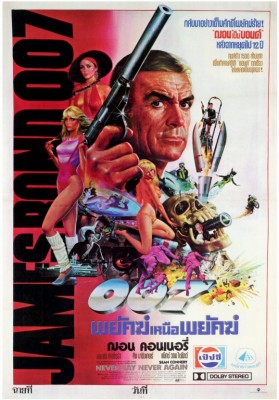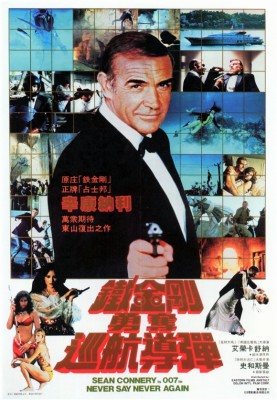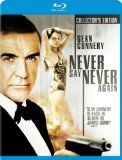| Reviews & Columns |
|
Reviews DVD TV on DVD Blu-ray 4K UHD International DVDs In Theaters Reviews by Studio Video Games Features Collector Series DVDs Easter Egg Database Interviews DVD Talk Radio Feature Articles Columns Anime Talk DVD Savant Horror DVDs The M.O.D. Squad Art House HD Talk Silent DVD
|
DVD Talk Forum |
|
|
| Resources |
|
DVD Price Search Customer Service #'s RCE Info Links |
|
Columns
|
|
|
Never Say Never Again
Unlike the no-frills DVD release from October 2000 - when amidst all those special edition Bond titles, this was dumped onto the market like a double-O Cinderella - this MGM/Fox release has a number of fascinating extras, including what may be the most negative behind-the-scenes featurette ever. The extras compensate somewhat for the disappointing audio; visually, however, the movie looks good most of the time.
The Thai (?) poster visually is a lot more interesting than the bland U.S. 1-sheets. Note also the Chinese (not Japanese) poster below.
At its core, Never Say Never Again is a remake of Thunderball (1965), or more specifically, a new adaptation of the 1961 novel, which unlike Ian Fleming's other books was based on an unproduced screenplay written in the late-1950s. What was intended as the first James Bond movie didn't happen, and when Fleming adapted the material into the novel, co-screenwriter/co-producer Kevin McClory sued and in an out-of-court settlement was awarded the story's movie rights. In 1964-65, McClory co-produced the first film version, also starring Sean Connery, with Eon Productions' Albert R. "Cubby" Broccoli and Harry Saltzman - with the understanding McClory could not make another Thunderball movie for at least 12 years, i.e., 1976. At the time, few would have imagined that the series would still be going strong.
But it was, and by this time Connery, having acrimoniously parted way with Eon, teamed up with McClory to remake Thunderball in a proposed film originally entitled Warhead. Eon sued and the project stalled, though supposedly a number of elements from Warhead's treatments suspiciously turned up in Eon's The Spy Who Loved Me (1977), which originally was to have featured arch-nemesis Blofeld and his SPECTRE organization.
It wasn't until Warner Bros. and producer Jack Schwartzman, husband of actress Talia Shire, became involved that the project was revived. According to that gloomy featurette, there was a constant struggle among the writers, producers, and Connery about what tone the material should take. While the screenplay is credited to Lorenzo Semple, Jr. (the Batman TV show, Papillon, King Kong), much of it was rewritten by an uncredited Dick Clement and Ian La Frenais (The Bank Job).
Both the 1965 Thunderball and the 1983 Never Say Never Again follow the main points of Ian Fleming's novel/adaptation fairly closely: SPECTRE, headed by Ernst Stavro Blofeld (Max von Sydow), steals two nuclear warheads, threatening to explode them unless the nations of the world pay an enormous ransom: each country is to pay an amount equal to 25% of their annual oil purchases. (Hey - that could run into money!) The operation, dubbed "The Tears of Allah," is being supervised by SPECTRE operative Maximilian Largo (Klaus Maria Brandauer) who lives aboard a colossal yacht, the Flying Saucer, with his girlfriend, Domino Petachi (Kim Basinger).
Meanwhile, James Bond (Connery) is sent by MI6's obnoxious new "M" (Edward Fox) to a health clinic where, coincidentally, he runs into two of "The Tears of Allah's" major players: SPECTRE agent Fatima Blush (Barbara Carrera) and Domino's U.S. Air Force officer brother, Jack (Gavan O'Herlihy, son of veteran actor Dan O'Herlihy but a dead ringer for American actor William Atherton). A heroin addict, Jack is being blackmailed by SPECTRE into accessing the U.S. President's personal launch codes.
Amidst a lot of good stuff, Never Say Never Again has two big problems working against its success. The first is that it has no choice but to be a remake of Thunderball and that so much of the writing, indeed all of the major creative decisions, were subject to the approval of lawyers and the insurance company covering the production against a lawsuit from Eon. That's not exactly the ideal way to write a script, and the result is that Never Say Never Again becomes uninteresting when, almost mechanically, it hits Thunderball's major plot points. Conversely, the viewer can sense the filmmakers' enthusiasm when new material is presented, particularly when it veers off in directions the Eon films up to that point had never attempted.
A related problem is that Never Say Never Again can't avoid being compared to the 1965 film. Thunderball was released at the pinnacle of Bond-mania, when the '60s-style spy movie was still a new experience full of surprises. It's a big-scale, brassy film, while Never Say Never Again has a postmodern, jaded sensibility about the spy game (symbolized by the new "M"). One thing that's surprising about Never Say Never Again is its comparatively scaled-back look. Thunderball cost about $5.6 million to make and Never Say Never Again cost more than six times that, about $36 million. Yes, inflation must be factored into this equation, but even so Thunderball looks like an epic and Never Say Never Again cuts a lot of corners and seems undernourished much of the time. In Thunderball, for instance, there's a big-scale theft of an Avro Vulcan jet bomber, which (as in the book) spectacularly crash lands in the ocean where, after it gently sinks to the sandy bottom, its nuclear bombs are stolen. In Never Say Never Again there's none of this; Jack Petachi sets the theft into motion via a remote computer in a small control room; the adjacent missile test control room has all of five or six guys at Irwin Allen-esque computer screens. (Actually, the basic plot of Never Say Never Again is also virtually identical to the 1978 Superman, but that's another story.)
The other major problem with Never Say Never Again is its appallingly bad score, written by eclectic Frenchman Michel Legrand. It's hard to say which is worse: the many scenes with no music at all, crying out, pleading for underscoring, or scenes actually accompanied by Legrand's score, which almost always is either totally inapt or just plain awful. It's easy to see why he was selected: Legrand had written great film scores in the past (notably for Jacques Demy's The Umbrellas of Cherbourg and The Young Girls of Rochefort), added a continental flavor in keeping with its Nice locations, and his jazz/arranger background was not unlike contemporary John Barry, whose involvement with 10 of the previous 13 Bond movies defined Eon's series as much as anyone. (Why didn't they reject Legrand's score and get Barry himself? It seems unlikely that he would have been contractually tied to Eon's series exclusively.) Note: Several readers, including Wei Jing and Gary Teetzel, have pointed out that Barry was indeed approached but declined, out of loyalty to Cubby Broccoli and his team. Thanks for pointing this out; it explains a lot!
Unfortunately, the results only add to the cheap feel of the production. This is perhaps most obvious in the terrible opening titles/title sequence, with Bond single-handedly assaulting an armed camp in a Central American jungle, apparently to rescue a kidnapped woman. It's not a bad sequence per se, though it gives Connery a terrible entrance after his 12-year absence; a more dramatic one could have had theater audiences cheering; instead, here he just kind of shows up, a figure coming into view, slinking out of the jungle foliage. And, "in one of the worst decisions in postproduction history," as writer Clement accurately describes it, "they put a [love] song over it." Legrand's music and the song's lyrics are totally at odds with what's onscreen: "You've got all the moves / Ah, but baby I've got them, too / No matter your attitude or your mood / I'll come through," etc. Back in 1983 when it was new, you could sense the theater audience's initial excitement suddenly tempered with disappointment.
On the other hand, much of the rest of the film is very, very good. At the center, unsurprisingly, is Sean Connery. It's hard to believe but back then, when he was 53 years old, people wondered if he wasn't too old to be playing the character. Quite the opposite of Roger Moore, Connery probably could have gotten away playing Bond into his early seventies. This reviewer and probably Connery himself would have preferred a Bond sans the obvious toupee Connery wears in the film, but otherwise he's an older but appreciably wiser 007. Connery's performance benefits from Never Say Never Again's superior dialogue. It's witty without resorting to the groan-inducing bad puns of the Roger Moore Bonds. Indeed, many of the picture's best scenes give Connery memorable dialogue, especially in his climatic confrontation with Fatima Blush, one of the best-ever Bond villainesses.
Carrera is terrific, her performance sadly somewhat overshadowed by Brandauer's more psychological, unusual but overrated portrayal. But Carrera expands upon Luciana Paluzzi's counterpart, Fiona Volpe in Thunderball, as a force of nature, a dominatrix-like sexual predator that moves like she's dancing a perpetual samba. (More the shame Legrand's score utterly fails to accentuate this.) Brandauer's Largo is much less striking than Adolfo Celi's eye patch-wearing super-villain, but Brandauer's psychological approach to the character, playing up the possessive, abusive lover, a smiling psychopath with eccentric, understated and/or ironic facial expressions that precede his violent outbursts, won just praise - even if the audience only gets to see the character's effects, without any glimpse into the causes.
Though Basinger's Georgia accent is a bit jarring (she's from the same city as Oliver Hardy!), she's undeniably gorgeous in this, and expresses the character's fragility well. Von Sydow, the best-cast of all the movie Blofelds, has too little screentime, as does Bernie Casey, one of the best Felix Leiters (Bond's CIA counterpart), and the first African-American one. (The inventive casting and lack of racial stereotypes - well, at least until you get to the Arabs - is refreshing. SPECTRE, for instance, is now an equal opportunity employer; its uppermost ranks include men and women of various races.) Supremely talented comedian Rowan Atkinson appears in a few scenes as a bumbling agent, but his appearances are unfunny and rather embarrassing.
Beyond Connery's performance and the good casting and performances of the other major roles, several action set pieces stand out, though they're few and far between. At the health clinic there's an excellent, very long fight sequence between Bond and a beefy SPECTRE agent (Pat Roach). It's violent and both staged and cut much like the Peter Hunt-edited fight scenes in the early Bonds, and it concludes on a very humorous note. Late in the film there's a terrific, sexually-charged chase between Fatima, in a car, while Bond pursues her on a modified motorcycle, a variation of the famous Aston Matin. (Bond's beloved Bentley, from the Ian Fleming novels, makes a cameo appearance.)
Video & Audio
Filmed in 2.35:1 Panavision with original prints by Technicolor, Never Say Never Again looks good but not outstanding. Straight cuts have a pleasing grain and level of detail that notably improves upon the 16:9 DVD release, but opticals and the title elements are soft and murky. The 1080p transfer is on a 50GB dual-layer disc like the other Bond releases.
The 5.1 DTS-HD Master Audio and 3.0 Dolby Surround (per the original release) are a big disappointment. You know something's wrong when the Orion logo music (replacing the original Warner Bros. logo) is five times more powerful than the main title theme. Both tracks lack oomph and there's very little sense of directional dialogue and sound effects, and even the score seems muddier than my old 45rpm of Lani Hall's theme song. French and Spanish mono tracks are also included, along with subtitle options in Spanish, Cantonese, Mandarin, Korean, and Thai. The disc is closed-captioned.
Extra Features
The highlight of the amusing, impressively frank supplements (all 16:9 SD) is The Big Gamble, a 16-minute behind-the-scenes overview featuring director Irvin "Kersh" Kershner, Lorenzo Semple, Jr., Dick Clement and Ian La Frenais, Talia Shire Schwatzman, John Schwartzman (son of Jack and Talia), Barbara Carrera, and Bond series historian Steven Jay Rubin. You get the feeling this was not a happy production, and the interviewees make no bones about the innumerable problems and the film's many shortcomings. Kersh complains a lot about the script. Sean Is Back (eight minutes) suggests Connery was entirely professional but unenthused, though everyone speaks highly of him. Kersh complains about Klaus Maria Brandauer. The Girls of 'Never Say Never Again' (10 minutes) features more of Carrera, Valerie Leon (the "Lady in Bahamas" also appears in The Spy Who Loved Me) and Pamela Salem ("Miss Moneypenny"). Kersh complains about Kim Basinger, who otherwise does not appear. Fast Carrier Productions produced the featurettes.
Kersh gets to complain some more on the audio commentary track with Steven Jay Rubin. It's less amusingly frank but does an okay job unraveling the convoluted, troubled production; laserdisc fans will remember Rubin for his long-lost but highly memorable Criterion tracks he recorded for Dr. No, From Russia with Love, and Goldfinger. Unfortunately, Kersh seems to think he's been brought in to record descriptive audio for the visually-impaired; he's constantly describing what's happening onscreen, and after a while it'll have you climbing the walls.
Also included is a photo gallery in high-def and a trailer which is not. In fact it's 4:3 panned-and-scanned (!), probably because MGM/Fox couldn't get trailer material out of Warner Bros.
Parting Thoughts
Despite several major complaints, Never Say Never Again ranks above average in the James Bond canon. Connery's presence alone carries a lot of weight; for many he remains the one, the only true James Bond of the movies. But it's a fine film in other ways, and with the exception of the below-par audio the Blu-ray disc offers a fine presentation with decent extra features. For Bond fans, this is Highly Recommended.
Film historian Stuart Galbraith IV's latest book, The Toho Studios Story, is on sale now.
|
| Popular Reviews |
| Sponsored Links |
|
|
| Sponsored Links |
|
|
| Release List | Reviews | Shop | Newsletter | Forum | DVD Giveaways | Blu-Ray | Advertise |
|
Copyright 2024 DVDTalk.com All Rights Reserved. Legal Info, Privacy Policy, Terms of Use,
Manage Preferences,
Your Privacy Choices | |||||||















